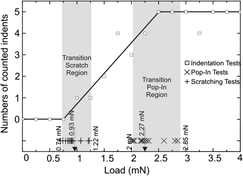Crossref Citations
This article has been cited by the following publications. This list is generated based on data provided by
Crossref.
Zhou, Hongxiu
Qiu, Shuo
Zhang, Xianzhong
and
Xu, Chaoge
2012.
Mechanical characteristics of soft-brittle HgCdTe single crystals investigated using nanoindentation and nanoscratching.
Applied Surface Science,
Vol. 258,
Issue. 24,
p.
9756.
Wasmer, Kilian
Parlinska-Wojtan, Magdalena
Graça, Sérgio
and
Michler, Johann
2013.
Sequence of deformation and cracking behaviours of Gallium–Arsenide during nano-scratching.
Materials Chemistry and Physics,
Vol. 138,
Issue. 1,
p.
38.
Huang, J. Y.
Ponce, F. A.
Caldas, P. G.
Prioli, R.
and
Almeida, C. M.
2013.
The effect of nanoscratching direction on the plastic deformation and surface morphology of InP crystals.
Journal of Applied Physics,
Vol. 114,
Issue. 20,
Fang, Qihong
and
Zhang, Liangchi
2013.
Emission of partial dislocations in silicon under nanoindentation.
Journal of Materials Research,
Vol. 28,
Issue. 15,
p.
1995.
Lee, Jong Hoon
Pin, Min Wook
Choi, Su Ji
Jo, Min Hyeok
Shin, Jae Cheol
Hong, Seong-Gu
Lee, Seung Mi
Cho, Boklae
Ahn, Sang Jung
Song, Nam Woong
Yi, Seong-Hoon
and
Kim, Young Heon
2016.
Electromechanical Properties and Spontaneous Response of the Current in InAsP Nanowires.
Nano Letters,
Vol. 16,
Issue. 11,
p.
6738.
Geetha, D.
Joice Sophia, P.
Radhika, R.
and
Arivuoli, D.
2017.
Evaluation of nanoindentation and nanoscratch characteristics of GaN/InGaN epilayers.
Materials Science and Engineering: A,
Vol. 683,
Issue. ,
p.
64.
Dub, S. N.
Petrusha, I. A.
Bushlya, V. M.
Taniguchi, T.
Belous, V. A.
Tolmachova, G. N.
and
Andreev, A. V.
2017.
Theoretical shear strength and the onset of plasticity in nanodeformation of cubic boron nitride.
Journal of Superhard Materials,
Vol. 39,
Issue. 2,
p.
88.
Geetha, D
Pratyank, R
and
Kiran, P
2018.
Nano-deformation behavior of silicon (100) film studied by depth sensing indentation and nanoscratch technique.
Materials Research Express,
Vol. 5,
Issue. 4,
p.
046407.
Ye, Y.X.
Liu, C.Z.
Wang, H.
and
Nieh, T.G.
2018.
Friction and wear behavior of a single-phase equiatomic TiZrHfNb high-entropy alloy studied using a nanoscratch technique.
Acta Materialia,
Vol. 147,
Issue. ,
p.
78.
Zhou, Qing
Du, Yin
Ren, Yue
Kuang, Wangwang
Han, Weichao
Wang, Haifeng
Huang, Ping
Wang, Fei
and
Wang, Jian
2019.
Investigation into nanoscratching mechanical performance of metallic glass multilayers with improved nano-tribological properties.
Journal of Alloys and Compounds,
Vol. 776,
Issue. ,
p.
447.
Chrobak, Dariusz
Trębala, Michał
Chrobak, Artur
and
Nowak, Roman
2019.
Origin of Nanoscale Incipient Plasticity in GaAs and InP Crystal.
Crystals,
Vol. 9,
Issue. 12,
p.
651.
Hu, Haixia
Liu, Zhiwei
Wang, Chengjun
Meng, Limin
and
Shen, Yuzhe
2019.
Nanomechanical Properties of a Bicomponent Epoxy Resin via Blending with Polyaryletherketone.
Journal of Composites Science,
Vol. 3,
Issue. 4,
p.
92.
Trabadelo, V.
Pathak, S.
Saeidi, F.
Parlinska-Wojtan, M.
and
Wasmer, K.
2019.
Nanoindentation deformation and cracking in sapphire.
Ceramics International,
Vol. 45,
Issue. 8,
p.
9835.
Chrobak, Dariusz
Chrobak, Artur
and
Nowak, Roman
2019.
Effect of doping on nanoindentation induced incipient plasticity in InP crystal.
AIP Advances,
Vol. 9,
Issue. 12,
Wang, Ke
Jiang, Feng
Li, Yaning
Wang, Ningchang
Hu, Zhongwei
Yan, Lan
Lu, Jing
Wen, Qiuling
and
Lu, Xizhao
2020.
Prediction of pop-in load for sapphires with different crystal orientations.
Ceramics International,
Vol. 46,
Issue. 5,
p.
6682.
George, Jeena
Mannepalli, Sowjanya
and
Mangalampalli, Kiran S. R. N.
2021.
Understanding Nanoscale Plasticity by Quantitative In Situ Conductive Nanoindentation.
Advanced Engineering Materials,
Vol. 23,
Issue. 9,
He, Wanjun
and
Zeng, Qunfeng
2021.
Enhanced micro/nano-tribological performance in partially crystallized 60NiTi film.
Friction,
Vol. 9,
Issue. 6,
p.
1635.
Chrobak, Dariusz
Ziółkowski, Grzegorz
and
Chrobak, Artur
2021.
On Incipient Plasticity of InP Crystal: A Molecular Dynamics Study.
Materials,
Vol. 14,
Issue. 15,
p.
4157.
Zhang, Zekai
Pan, Wenwu
Martyniuk, Mariusz
Ma, Shuo
Faraone, Lorenzo
and
Lei, Wen
2022.
Nanoindentation of Hg0.7Cd0.3Se prepared by molecular beam epitaxy.
Infrared Physics & Technology,
Vol. 127,
Issue. ,
p.
104446.
Chrobak, Dariusz
Dulski, Mateusz
Ziółkowski, Grzegorz
and
Chrobak, Artur
2022.
Effect of the Indentation Load on the Raman Spectra of the InP Crystal.
Materials,
Vol. 15,
Issue. 15,
p.
5098.





